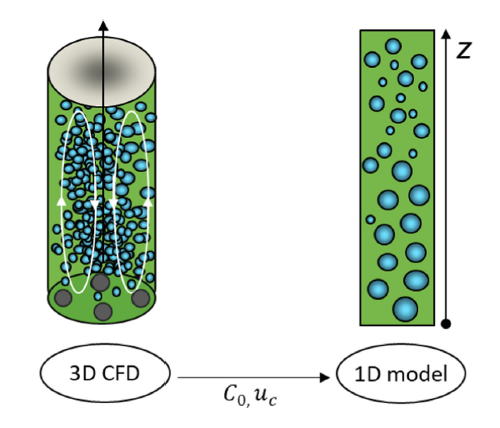Despite sporadic progress over recent years, global action on climate change looks to be gaining momentum following strengthened commitments made by developed countries at COP27 to reduce greenhouse gas emissions, with the aim of limiting global temperature rise to 1.5 degrees Celsius above pre-industrial levels.
However, it is becoming clear that existing renewable energy technologies will also need to be complemented by a more diverse mix of new energy technologies if we (as a global community) hope to achieve this goal.
Hydrogen is likely to be a key contributor to these global CO2 reduction efforts, and significant research is being conducted into the ability to produce hydrogen via electrolysis during periods of surplus electricity generation, and reaction in a hydrogen fuel cell to produce electricity. Ansys Fluent provides all the physical models and pre/post processing tools needed to study these processes. The hydrogen produced by electrolysis can also be used in combustion systems to produce heat, removing the need to burn fossil fuels and therefore reducing greenhouse gas emissions. Again, there has been significant development within Ansys Fluent to validate combustion models and mechanisms to allow not only industrial combustion of hydrogen to be studies but also safety issues such as flashback.
Excess hydrogen can also be used to upgrade gases emanating from waste water treatment plants. Anerobic digestion plants produce a mixture of CH4 and CO2 as an off gas, which can be upgraded to CH4, which can then be used as a feedstock for chemical processes, directly reducing the emitted CO2. A team from the Toulouse Biotechnology Institute at the Université de Toulouse and the School of Chemical and Biomolecular Engineering at the University of Sydney have recently published an article in Chemical Engineering Science [1] (free download until 12 February 2023 at this link) in which Ansys Fluent was used to model the bioreactor and validate simpler models for process design and optimisation.
The advanced multiphase capabilities of Ansys Fluent were used to develop an Euler-Euler multiphase model of the bubble column reactor that could be used to combine hydrodynamics with mass transfer and chemical reaction. Key to the work was being able to validate the model against experimental data and then use the model to explore different spargers and operating conditions. The University of Sydney group together with various international collaborators have worked over many years to validate Ansys Fluids software and optimise the solver performance for the study of bubble columns [2,3,4] and fermenters [5,6]. This work builds on that expertise and incorporates the best practices learned over many years.

As an example, a study was made both experimentally and computationally to compare the differences when using a porous plate and four discrete injection points to introduce the gas into the reactor. Fig. 1 shows the impact of the sparger design on the bubble-liquid interfacial area, mass transfer rate, H2 transfer rate and the methane mass fraction with all being improved when a porous plate is used for the sparger.
In addition, the detailed CFD simulation for the 4 sparger case were used to determine input parameters for a 1D model that runs extremely fast and can be used in system optimisation. This process of doing transient, 3D simulations to provide inputs into 1D models shows how CFD can be used to calibrate simpler models that are then used for process design and optimisation. The workflow is shown in Figure 2 and described in detail in the paper [1]. The key point is the use of detailed CFD data to extract the liquid circulation velocity and the distribution coefficient for use in a 1D drift flux model.

Summary
This blog has highlighted the capabilities of Ansys Fluent in modelling multiphase flows that involve gas liquid systems with mass transfer and biological reactions. Whilst this application targets carbon dioxide conversion to methane using hydrogen, it is clearly applicable to many other chemical processes. The work also shows how detailed 3D simulations can be used to calibrate simpler, computationally faster models. You can obtain a free copy of the publication before 12 February 2023 via this link.
References
[1] V. Ngu, D.F. Fletcher, J.M. Kavanagh, Y. Rafrafi, C. Dumas, J. Morchain and A. Cockx, H2 mass transfer – a key factor for efficient biological methanation: Comparison between pilot-scale experimental data, 1D and CFD models. Chem. Eng. Sci., 268, 118382, (2023).
[2] E. Ertekin, J.M. Kavanagh, D.F. Fletcher and D.D. McClure, Validation studies to assist in the development of scale and system independent CFD models for industrial bubble columns. Chem. Engng. Res. Des., 171, 1-12, (2021).
[3] Z. Huang, D.D. McClure, G.W. Barton, D.F. Fletcher and J.M. Kavanagh, Assessment of the impact of bubble size modelling in CFD simulations of alternative bubble column configurations operating in the heterogeneous regime. Chem. Eng. Sci., 186, 88-101, (2018).
[4] D.F. Fletcher, D.D. McClure, J.M. Kavanagh and G.W. Barton, CFD simulation of industrial bubble columns: Numerical challenges and model validation successes. Appl. Math. Model., 44, 24-42, (2017).
[5] G. Nadal-Rey, D.D. McClure, J.M. Kavanagh, B. Cassells, S. Cornelissen, D.F. Fletcher and K.V. Gernaey, Computational fluid dynamics modelling of hydrodynamics, mixing and oxygen transfer in industrial bioreactors with Newtonian broths. Biochem. Eng. J., 177, 108265, (2022).
[6] G. Nadal-Rey, D.D. McClure, J.M. Kavanagh, B. Cassells, S. Cornelissen, D.F. Fletcher and K.V. Gernaey, Development of dynamic compartment models for industrial aerobic fed-batch fermentation processes. Chem. Eng. J., 420(3), 130402, (2021).






